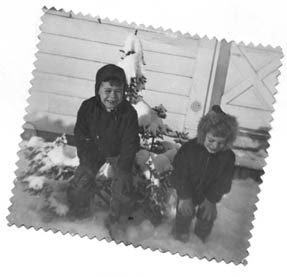My brother was a kindly and talented man who had much kindness and talent left to give the world when cancer took him suddenly and prematurely from us, the first day of 2001. Perhaps our lives intertwined more than is common for brothers in this modern world, who more often live far apart than near to one another. We were often to pull and push each other in various directions. In fact, my earliest memory of this life is of Jay pulling me in a wagon in New Orleans, in what was the first Mardi Gras after the end of World War II. A vague couple of years in Washington, and then a tumble of wonderful memories of Alaska. If you wanted to raise a couple of boys to become science fiction writers — a bizarre ambition, true — you couldn’t find a better place than the Territory of Alaska in the late forties and early fifties. The huge and awesome beauty of it, the sense of living on the edge of the world. Its isolation meant we were the last American children to grow up without the baleful eye of television. Instead we were glued to the radio, making up the pictures in our own minds.
We returned to the Washington area to grow up, where Jay and I would be responsible for supplying each other wives. I met Gay, to whom I’m still married 41 years later, because Jay had convinced me to join DeMolay, a Masonic youth group. None of our family had ever been Masons, but the sales pitch included beer and girls, two central interests in our late teens. (And even later, if the truth be told.) I met Gay at a dance they sponsored.
I introduced Jay to Alice in a more science-fictional way. After a couple of years at the University of Oklahoma, we’d returned to Maryland. I had to make up a few credits in summer school, and waiting for a government and politics class to begin, I was leafing through a science fiction magazine. A pretty girl came up and said “Oh, is that the new Analog?” I later found out that her interest was not in me or the magazine, but in avoiding the attentions of another guy in the class. But in the course of chatting about sf, she gave me the address of WSFA, the Washington Science Fiction Association, which profoundly changed all our lives.
Jay and I were both stone science fiction readers, back in the days when it was still possible to read everything that came out, but we didn’t know anything about sf fandom. He took to it like a Denebian slime worm to methane, winding up being WSFA president for many years, chairing the 1974 World Science Fiction Convention, and of course marrying Alice, who gave to him and me the wonderful daughter and niece Lori.
Jay plunged into the weird subculture of sf fanzine publishing, starting with a rickety mimeograph and winding up with a gargantuan state-of-the-art printing press. He honed his writing and editing skills with the eclectic fanzine Tapeworm.
Immediately after college I got drafted, and Jay protested my being hijacked to Vietnam by letting his hair grow. He let it grow past his waist and left it that long until the end of his life. Before he went into chemotherapy, we had a ceremony where we both had our hair cut together.
Most serious writers, rather than studying writing in college, go through a salon stage, where they get together with other young writers and talk about each other’s work. Jay ran a very successful one in Baltimore through the seventies, obscurely called the Guilford Gafia, which brought together young writers from New York to Florida, to argue intensely and form life-long friendships.
Oddly enough, the only one of us who didn’t succumb to full-time writing and editing was Jay, who for most of his writing career had a side job in the sciences or medicine. He was the only one of us who had a child to care for, but I think it was more than parental responsibility. He loved labs and computers, and his science fiction was better for it.
We both fell in love with Florida when we came down for the Orange Bowl with the University of Oklahoma band in 1962, and both moved down in the seventies, for the sunshine and cheap living and no state income tax — but mainly for the space program. We were avid space junkies, going to every launch we could, invading the press site with our barely legitimate credentials from science fiction magazines. The high point of Jay’s involvement was Apollo 17, the night launch that took the last crew to the moon. Always a serious photographer, Jay took both moving and still pictures of the dramatic sight, and one of them wound up on the cover of Amazing magazine.
Jay became a much more successful Southerner than I ever could, and he got more deeply into the spiritual side of Florida, with many connections to the Native Americans here. He loved the music — Will McLean and Gamble Rogers, and Jimmy Buffett before there were any Parrotheads. He lived variously on the beach, in a swamp, on a farm, and finally in the university town Gainesville.
He leaves behind a wife and daughter, eight books and a hundred stories, and if he had only one biological brother, he had dozens of brothers and sisters of the kind you have to earn.

